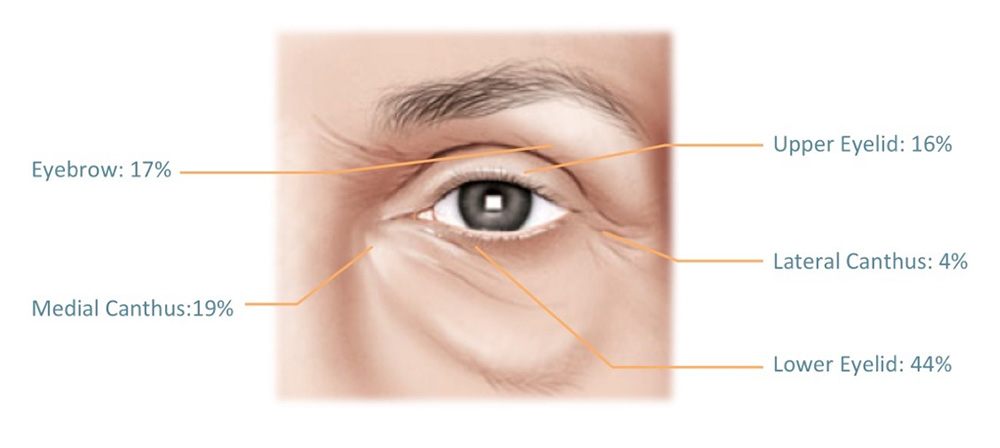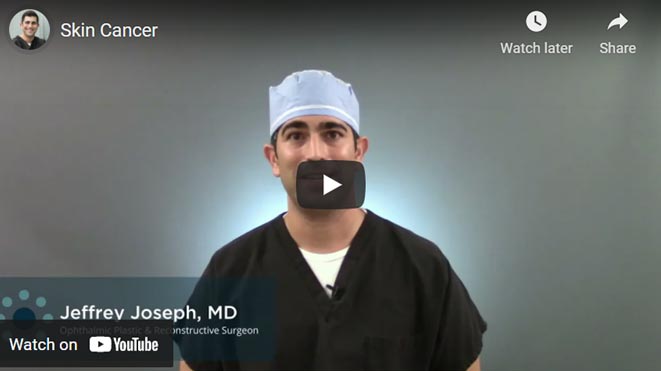EYELID SKIN CANCER
ORANGE COUNTY
Orange County’s Best Eyelid Surgery Center
Although there are many types of skin cancer which can affect the region around the eyes, the three most common are basal cell carcinoma, squamous cell carcinoma and melanoma. Most types of skin cancer are thought to be caused by excessive sun exposure. This exposure may have occurred relatively recently or in the more distant past. This is a very common issue in Orange County due to our Southern California climate.
Whatever the cause, you can rest assured that Dr. Joseph has the answer to all of your needs for eyelid cancer surgery.
DO I HAVE EYELID CANCER?
There are three main factors that contribute to the ability to reliably deliver natural results with eyelid surgery.
1.Experience –
Dr. Joseph focuses his practice on both aesthetic and reconstructive procedures of the eyelids. He also helps to train the residents in training at UC Irvine, where he is an assistant professor.
2.Ability – To reliably achieve optimal results from each eyelid surgery, one must have the physical skills to perform surgery on the most fragile, delicate facial area. Dr. Joseph is a trained microsurgeon and possesses the skills and ability to achieve these results.
3.Knowledge – The last and most vital factor is understanding the eyelids and their ideal balance and relationships to the surrounding areas, the eyebrow, the cheek, and the eye itself. Dr. Joseph has unsurpassed knowledge of anatomy in this area, and this knowledge is paramount in delivering your desired results.

5 to 10% of all skin cancer occurs around the eyes
HOW IS EYELID CANCER TREATED?
Biopsy
If Dr. Joseph finds a concerning growth, the next step in identifying an eyelid cancer is a biopsy. A biopsy is a small, in-office procedure. There is minimal downtime and recovery after a biopsy. The results determine if further treatment is needed.
Mohs Micrographic Surgery
Mohs micrographic surgery is a highly specialized surgical technique for eyelid skin cancer removal. The goal of Mohs surgery is to provide the most advanced and sophisticated method to remove the cancer while leaving all the unaffected surrounding structures intact. This is particularly important for eyelid cancer as there are many small, fragile, vital structures on and around the eyelids.
During Mohs surgery the cancer is shaved off one level (layer) at a time and is immediately examined under the microscope. This method has the highest cure rate while preserving vital healthy tissue and maximizing cosmetic results.
This procedure is most commonly used to treat Basal Cell and Squamous Cell Carcinomas, but recently some cases of melanoma have been included. Mohs surgery is often suggested when it is critical to preserve as much healthy tissue as possible as is certainly the case with the eyelids and surrounding areas.
Reconstruction Following Mohs Surgery
Surgical repair (reconstruction) depends on the size, depth, and location of the cancer. As an oculoplastic and cosmetic surgeon, Dr. Joseph has extensive experience in reconstructing eyelids after cancer removal. It is this experience and focus that will maximize your cosmetic result while preserving the structure and function of the eyelid vital to the health of your eyes and vision.
If you or your doctor suspect that you may have cancer on or around the eyelids, a consultation with Dr. Joseph in his Newport Beach office is your first step.
Click here to contact Dr. Joseph’s Newport Beach office and schedule your consultation.
WHAT ARE COMMON TYPES OF SKIN CANCER?
The most common type of skin cancer is basal cell carcinoma. This can affect any area on the body. Around the eye, the lower eyelid and inside corner of the eye are most commonly affected. Basal cell carcinomas tend to grow locally and slowly.
The second most common type of skin cancer is squamous cell carcinoma. This again can be found anywhere on the body, including the eyelids. Although sun (or UV) exposure is likely a common cause, other potential risk factors include a history of radiation exposure, severe burns, coal tar or previous precancerous lesions such as an actinic keratosis.
A third type of skin cancer that can affect the periocular skin is melanoma.
Although only about 1% of eyelid cancers are melanomas, they may behave much more aggressively than most other types of skin cancer. This is emphasized in the fact that although only about 3% of all skin cancers are melanomas, they account for about two thirds of deaths related to skin cancer.
Although suspicious lesions should be evaluated by a physician, it is a good idea for everyone to know the ABCD’s of melanomas. A is for asymmetry. This means that one half of the lesion is different than the other half. B is for border irregularity. Instead of being smooth, suspicious lesions have uneven or notched borders. C is for color. A mixture of colors such as components of black, brown or tan makes a lesion suspicious. Finally, D is for diameter. If an area is greater than 6mm or about one half of an inch, it is also considered suspicious. If there is evidence of a suspicious lesion, you should contact your physician.
Before & After

PREVENTION
Sun or UV exposure is a significant risk factor for many types of skin cancer. Therefore, limiting exposure over a lifetime can decrease the chances of developing skin cancers. It is best to stay out of the sun from 10am to 4pm when the sun’s rays are most harmful. It is important to wear a broad-spectrum (UVA and UVB) sunblock on all exposed areas of the skin which may be exposed to the sun. Additionally wearing a wide brimmed hat and sunglasses with UV protection may is very helpful to protect the face from the sun’s harmful rays. Due to the climate here in Orange County, we are particularly susceptible to UV skin damage and skin cancer.
